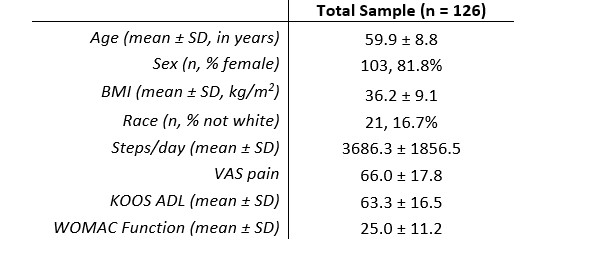Session Information
Date: Tuesday, November 14, 2023
Title: (1973–1976) Orthopedics, Low Back Pain, & Rehabilitation Poster
Session Type: Poster Session C
Session Time: 9:00AM-11:00AM
Background/Purpose: Knee osteoarthritis (OA) is a leading cause of disability and functional limitation in older adults. Treatments for knee OA focus on symptom management, with physical activity, e.g., exercise, receiving high recommendations. However, misconceptions about exercise are common, affecting an individual’s beliefs about the benefits of exercise. Currently, little is known about the characteristics of those who have high positive and high negative beliefs about exercise. This study aims to explore how demographic factors, baseline physical activity (steps/day), and knee related outcomes differ between those with positive and negative treatment beliefs related to exercise in adults with knee OA.
Methods: We conducted a secondary analysis of baseline data from a clinical trial examining a telehealth physical therapy intervention for adults with knee OA. Included were adults within the United States who met the National Institute of Health and Clinical Excellence criteria for knee OA ( > 45 years, activity related knee pain, and < 30 min of morning stiffness) and did not regularly exercise. Positive and Negative treatment beliefs were measured using the Treatment Beliefs in Knee and Hip OA (TOA) Physical Exercise (PE) questionnaire which include positive and negative subscales. High positive beliefs were defined as scores greater than 14 on the positive subscale while high negative scores were defined as scores greater than 8 on the negative subscale. These represent more than neutral agreement to positive/negative beliefs. We reported subject characteristics stratified by High Positive and High Negative Beliefs, which included age, sex, BMI, race, Visual Analog Scale (VAS) pain, steps/day, Knee Osteoarthritis Outcome Survey Activities of Daily living subscale score (KOOS ADL), and Western Ontario and McMaster Universities Osteoarthritis Index Function subscale score (WOMAC Function).
Results: 126 participants (mean age = 59.9 years old, 82% female, mean BMI = 36.2 kg/m2) were included in the analysis (Table 1). Of those included, 73% (92/126) of the sample had high positive treatment beliefs and 26% (33/126) had high negative treatment beliefs. The high positive belief sample had a smaller proportion of females (77.1% vs 94.1%) than the low positive belief sample. Participants with high negative beliefs tended to be younger (56.4 years vs 61.2 years), had a higher BMI (39.1 kg/m2 vs 35.2 kg/m2), had higher pain (72.6 vs 63.6), had higher daily step count (4028.4 steps/day vs 3567.9 steps/day), and worse WOMAC physical function scores (28.3 vs 23.8) than those with low negative beliefs. (Table 2).
Conclusion: While the demographic makeup of individuals with high versus low positive treatment beliefs were relatively similar outside of sex, there may be some differences for high versus low negative treatment beliefs. A limitation to this study is that these differences were not formally tested due to relatively small sample size. This exploratory examination of group characteristics suggests that differences in treatment beliefs may be related to some patient characteristics, pain, and functional outcomes, however further research is needed to formally study these potential differences.
To cite this abstract in AMA style:
Liles S, Jakiela J, Bye T, Copson J, White D. Do You Believe in Exercise for Osteoarthritis? Exploring Differences in Participant Characteristics with Treatment Beliefs in Exercise for Knee Osteoarthritis [abstract]. Arthritis Rheumatol. 2023; 75 (suppl 9). https://acrabstracts.org/abstract/do-you-believe-in-exercise-for-osteoarthritis-exploring-differences-in-participant-characteristics-with-treatment-beliefs-in-exercise-for-knee-osteoarthritis/. Accessed .« Back to ACR Convergence 2023
ACR Meeting Abstracts - https://acrabstracts.org/abstract/do-you-believe-in-exercise-for-osteoarthritis-exploring-differences-in-participant-characteristics-with-treatment-beliefs-in-exercise-for-knee-osteoarthritis/


